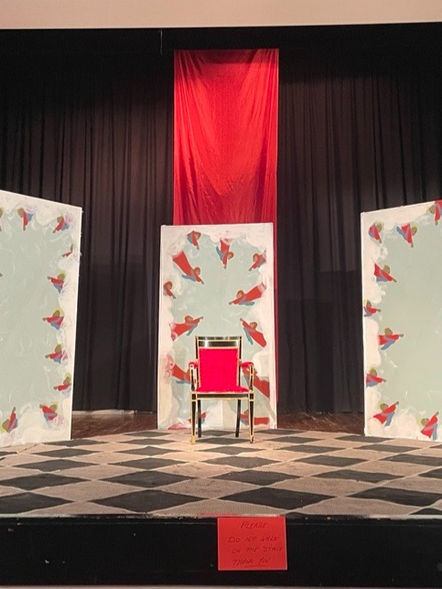SADIE O'NEILL PORTFOLIO
Rosencrantz and Guildenstern are Dead
"Rosencrantz and Guildenstern Are Dead" is a play written by Tom Stoppard that was first performed in 1966.
The play is a clever and humorous reinterpretation of Shakespeare's "Hamlet," focusing on the two minor characters, Rosencrantz and Guildenstern. It explores their bewildering experiences and existential dilemmas as they navigate the events of "Hamlet" from the sidelines.
The play raises questions about fate, free will, and the absurdity of human existence, all while delivering witty wordplay and philosophical discussions. It's a metatheatrical and thought-provoking work that combines elements of comedy and tragedy.
I will be marked on set design for this script piece.
Drawing's
In the initial stages of my set design process, I researched previous productions to gain insights into their set designs and the underlying reasons for their choices. I drew up some quick simple sketches to see how i wanted to go about using the space.

Model's
Having narrowed down my preferred design concepts, I develop my initial 3D models, showing a scaled-down preview. This model was for Act 2 and embodied my vision for a set that struck a balance between detail and minimalism. It was also tailored to accommodate our idea of having the audience seated on the stage itself.

Set Design
The final set design I settled on was for Act Two, capturing the magnificence of the Court of Elsinore. The stage featured elevated platforms with tapestries surrounding the space, providing concealed areas for actors. To emphasise the richness of the court, I opted for a checkered flooring design, which added to the visual wealth of the set. This is a simple version of the final set as this is an ongoing piece which will be invigilated in February.
_edited.jpg)
The Development
The choice of a minimalistic but detailed set design for Act 2 of "Rosencrantz and Guildenstern Are Dead" in the court of Elsinore serves to enhance the thematic elements of the play while also staying relevant to the time period.
The checkered flooring symbolises the wealth and opulence of the court. In the Renaissance era, checkered patterns were often associated with luxury and grandeur. The contrast between black and white tiles not only creates a visually striking stage but also reflects the duality and ambiguity that are prevalent themes in the play.
The tall walls draped with Renaissance wallpaper serve a dual purpose. Firstly, they act as visual representations of the court's artistic and cultural richness. The wallpaper, reminiscent of paintings, adds a layer of sophistication and establishes a connection to the historical period. Secondly, these walls provide the actors with opportunities for concealment and peeking out, aligning with the theme of surveillance and manipulation present in the play. The characters of Rosencrantz and Guildenstern often find themselves under scrutiny, and the set design reflects this constant observation.
The three tall walls not only frame the room but also offer hiding spots for the characters. This feature reinforces the themes of uncertainty, hidden agendas, and the characters' lack of control over their own destinies. The minimalistic approach allows the actors to navigate the space in intriguing ways, emphasising the confined and manipulated nature of the characters.
Placing a gold chair with red cushions at the centre stage draws attention to a focal point of power and authority. Gold is a colour associated with royalty and importance, and the red cushions add a touch of drama and intensity to the scene. This central element represents the seat of power in Elsinore and serves as a constant reminder of the political intrigue and power dynamics at play.
The design stays relevant to the Renaissance period, both aesthetically and thematically. The use of Renaissance wallpaper, the gold chair, and the checkered flooring are all elements that resonate with the visual and cultural cues of the time. This adherence to historical context enhances the audience's immersion in the world of the play.
The minimalistic nature of the set design ensures that the focus remains on the characters and their interactions. It avoids unnecessary distractions, allowing the audience to engage more deeply with the existential questions and absurdity explored in the play. The simplicity of the set also complements the complex and philosophical nature of Tom Stoppard's script.












